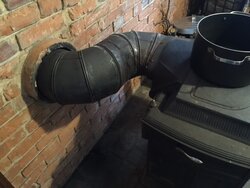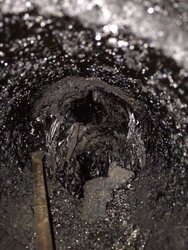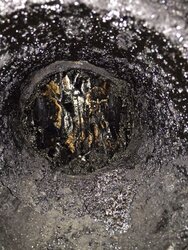First, thank you all for the great info already gathered!
Here's my situation.
We just moved into a rental home with a Vermont Castings Vigilant (early to mid-1980's), with a rear exit. Off the stove is a single wall, 8" oval male-90 degree (horizontal)- 8" round female pipe, connected to another 8" horizontal 90 degree pipe, connected to an 8" to 6" adapter, all going into a 6" T-section and straight up a 30-ish foot SS flexible liner. No insulation as far as I can tell except for the original 6"x6" terracotta liner. The chimney is centrally located in the home and extends about 6' above the roof peak. We have draft problems due to living at the bottom and downwind of a big ridge a 1/4 mile away. I know this stove should have an 8" liner. But the owners claim to have used it many years with well seasoned wood with no issues and sweeping the chimney twice a season.
We bought supposedly 3-year seasoned wood from a reputable place (And I understand "seasoned wood" is not really seasoned). After 3 or 4 daylong fires, TOTAL CREOSOTE BLOCKAGE, primarily in the T-section and about 1-2 feet above it.
What I've done so far thinking it was a draft issue: Cleaned out the stove (a bucket full of creosote and ash caked inside all the rear chambers of the stove), Installed a Vacu-Draft cap, bricked up the clean out and installed an iron door (the owners used fiberglass insulation and loose bricks). Brought all the wood inside hoping to speed up the seasoning process.
Now have awesome draft. After 10 minutes using the top-down method, it sounds like a jet engine in there. But still after 1-2 fires, total blockage.
What I'll be doing this weekend: Installing all double wall (thinking the flu is cold and the retained heat might help to move exhaust up) 8" oval to 6" round pipe (made for VC stoves), 2 x 6" 45 degree elbows (thinking 3 x 90 degree turns before the exhaust goes up is too many) (this will also do away with the 8"-6" reducer which may be choking the system right before the vital turn up into the liner), a new T-section as the existing one is mangled and doesn't mate well at the vertical and horizontal section, and a 6" x 48" SS liner pipe and cap to go down into the clean out in case there are any leaks in the brick/terracotta chimney. I'll also be building a proper wood shack to season a few cords for next year.
My questions are: Could any one of these existing no-no's really cause a total blockage after 1-2 fires? And will any or all of my fixes help to remedy the problem until we can get a new stove meant for a 6" liner this summer when the money's there? I don't mind sweeping a few times a season, but after every fire is kind of ridiculous. I included a photo if my setup explanation doesn't make sense.
Thank you in advance for any advice.
Here's my situation.
We just moved into a rental home with a Vermont Castings Vigilant (early to mid-1980's), with a rear exit. Off the stove is a single wall, 8" oval male-90 degree (horizontal)- 8" round female pipe, connected to another 8" horizontal 90 degree pipe, connected to an 8" to 6" adapter, all going into a 6" T-section and straight up a 30-ish foot SS flexible liner. No insulation as far as I can tell except for the original 6"x6" terracotta liner. The chimney is centrally located in the home and extends about 6' above the roof peak. We have draft problems due to living at the bottom and downwind of a big ridge a 1/4 mile away. I know this stove should have an 8" liner. But the owners claim to have used it many years with well seasoned wood with no issues and sweeping the chimney twice a season.
We bought supposedly 3-year seasoned wood from a reputable place (And I understand "seasoned wood" is not really seasoned). After 3 or 4 daylong fires, TOTAL CREOSOTE BLOCKAGE, primarily in the T-section and about 1-2 feet above it.
What I've done so far thinking it was a draft issue: Cleaned out the stove (a bucket full of creosote and ash caked inside all the rear chambers of the stove), Installed a Vacu-Draft cap, bricked up the clean out and installed an iron door (the owners used fiberglass insulation and loose bricks). Brought all the wood inside hoping to speed up the seasoning process.
Now have awesome draft. After 10 minutes using the top-down method, it sounds like a jet engine in there. But still after 1-2 fires, total blockage.
What I'll be doing this weekend: Installing all double wall (thinking the flu is cold and the retained heat might help to move exhaust up) 8" oval to 6" round pipe (made for VC stoves), 2 x 6" 45 degree elbows (thinking 3 x 90 degree turns before the exhaust goes up is too many) (this will also do away with the 8"-6" reducer which may be choking the system right before the vital turn up into the liner), a new T-section as the existing one is mangled and doesn't mate well at the vertical and horizontal section, and a 6" x 48" SS liner pipe and cap to go down into the clean out in case there are any leaks in the brick/terracotta chimney. I'll also be building a proper wood shack to season a few cords for next year.
My questions are: Could any one of these existing no-no's really cause a total blockage after 1-2 fires? And will any or all of my fixes help to remedy the problem until we can get a new stove meant for a 6" liner this summer when the money's there? I don't mind sweeping a few times a season, but after every fire is kind of ridiculous. I included a photo if my setup explanation doesn't make sense.
Thank you in advance for any advice.




